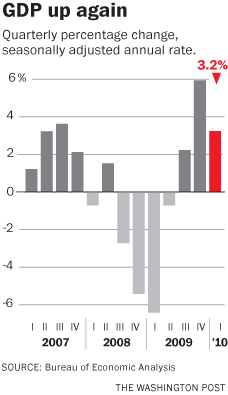
The Commerce Department reports that “[r]eal gross domestic product (GDP) increased 3.2 percent in the first quarter of 2010 after increasing 5.6 percent in the fourth quarter, according to estimates released today by the Bureau of Economic Analysis. The news of the uptick follows a rise in consumer confidence reported this week.
Economy grows at 3.2% rate in first quarter
By Neil Irwin
The U.S. economy grew at a 3.2 percent annual rate in the first three months of the year, evidence that the economic recovery continues to plug along but that growth is not accelerating in a way that would bring down joblessness rapidly.
The first-quarter gain in gross domestic product represents a deceleration from the 5.6 percent pace of growth in the final months of 2009, and is a bit below the 3.5 percent growth analysts were forecasting.
The growth in gross domestic product, the broadest measure of economic activity, was driven by a 3.6 percent rise in personal consumption expenditures. That is the largest component of GDP and suggests that American consumers are gradually coming out of their shells and returning to stores following the recession that probably ended last year.
“We’re heading in the right direction. We’re moving forward. Our economy is stronger,” President Obama said during an appearance at the White House with workers and business leaders. However, he acknowledged that the nation’s grudging recovery has not reached the point where all the damage of the downturn has been repaired.
The economic data “doesn’t mean much to an American that has lost his or her job and can’t find another,” Obama said. For those who are out of work, he continued, ” ‘you’re hired’ is the only economic news they’re waiting to hear.”
Indeed, Friday’s report from the Commerce Department confirms that the economy is expanding at a rate only a bit above its long-term trend — economists generally think that the nation’s economy can grow at 2.5 to 3 percent in the long run thanks to population growth and rising productivity.
Because growth is only barely outstripping that long-term trend, it could take quite some time for the unemployment rate, now 9.7 percent, to come down substantially. By contrast, following the last recession of similar depth, in 1982, there were several quarters of growth in the 7 to 9 percent range.
Still, the composition of the first-quarter economic expansion offers reason to hope that the growth is sustainable, if unspectacular. Fourth-quarter growth had been driven by businesses no longer drawing down their inventories so aggressively. That was essentially a one-time boost.
By contrast, the first-quarter expansion was driven in large part by American consumers, which is more sustainable.
In addition to the 3.6 percent rate of gain in consumption, business investment in equipment and software rose at a 13.4 percent annual rate, another contributor to growth. However, other forms of private investment declined, with investment commercial structures declining at a 14 percent rate and investment in residential structures down 10.9 percent.
Both exports and imports rose, but imports rose by more, so trade created a net drain on first-quarter growth.
And although federal government spending rose at a 1.4 percent annual rate, amid continued spending to stimulate the economy, state and local governments cut back their spending aggressively, at a 3.8 percent rate. That made government spending overall a net drain on economic activity.
Staff writer Debbi Wilgoren contributed to this report.
ATTENTION READERS
We See The World From All Sides and Want YOU To Be Fully InformedIn fact, intentional disinformation is a disgraceful scourge in media today. So to assuage any possible errant incorrect information posted herein, we strongly encourage you to seek corroboration from other non-VT sources before forming an educated opinion.
About VT - Policies & Disclosures - Comment Policy



